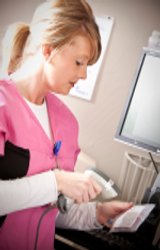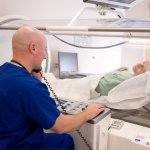Note from the mamas: This article contains some interesting info on how hospitals track medications to make sure thousands of patients get the right medications in the right dosages. The info was provided by Mercy Health System in NWA, nwaMotherlode’s corporate sponsor.
 The Sisters of Mercy Health System – a group of 26 hospitals in four states in middle America – has found ways to save $109 million in healthcare costs and avoid more than 150,000 potential medication errors that could have harmed patients.
The Sisters of Mercy Health System – a group of 26 hospitals in four states in middle America – has found ways to save $109 million in healthcare costs and avoid more than 150,000 potential medication errors that could have harmed patients.
Mercy was recently named the top healthcare supply chain operation in the world, just second overall to global giant Johnson & Johnson.
Katy Alspaugh, an Intensive Care Unit (ICU) nurse at Mercy Health Center in Oklahoma City, knows firsthand what it’s like to be one of the “have-nots” in a world where technology is increasingly becoming a medical worker’s best friend.
Mercy invested $35 million in 2003 in bar-code technology — just one element of a massive overhaul in how Mercy provides healthcare — to reduce potential medication errors. Only a quarter of hospitals in the nation use this technology, and it’s paying off big time for Mercy in improved patient safety.
“I remember one day when I was getting ready to give one of my patients an antibiotic from their medication drawer and, when I scanned the med in, the bar-code technology alerted me that it wasn’t my patient’s med,” Alspaugh recalled. “In the transition from pharmacy to our ICU, it ended up in the wrong place.”
In a long and complicated journey, medications make their way from supplier to patient, passing through a multitude of hands and steps. By putting technology to work, along with checkpoints at every turn, today on average every medication destined for a Mercy patient is tracked 10 to 20 separate times before it’s used.
“All medications continue to be electronically tracked throughout a patient’s stay at nearly every Mercy facility,” said Vance Moore, president of Resource Optimization & Innovation (ROi), Mercy’s supply chain division. “There’s a rigorous safety process in place before a medication ever reaches a patient. We want to do everything we can to reduce medication errors but not delay delivery to the patient.”
What everyone in healthcare already knows, but no one wants to admit, is that healthcare is different from any other industry because at the end of the day, it’s your life, your loved one’s life or your friend’s life at stake. And that’s where the cost of errors remains high.
“We wish, as nurses and medical professionals, that we were perfect, but we’re human and it’s a sobering truth we live with every day,” Alspaugh said. “So when there’s technology available that ensures my patients get the right meds and the right dose at the right time, I’m going to choose the hospital that helps me care best for my patient.”
With Mercy serving more than 2.7 million patients in the past year (throughout its system), eliminating redundancy in processes and systems has also meant nurses, pharmacists and other medical workers have fewer distractions, allowing them to do what they do best – care for patients.
The Sisters of Mercy Health System – the eighth largest Catholic healthcare system in the U.S. – includes 26 hospitals and more than 1,300 physician practices in Arkansas, Kansas, Missouri and Oklahoma.




